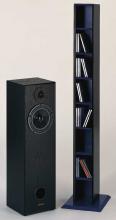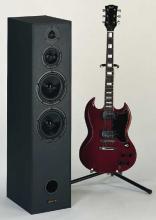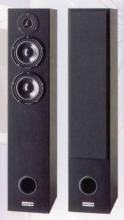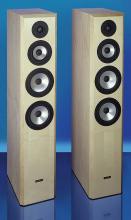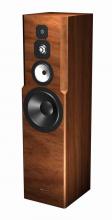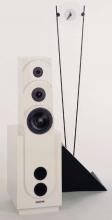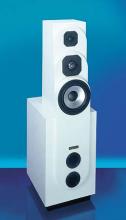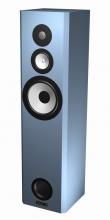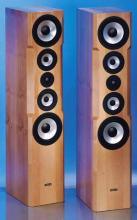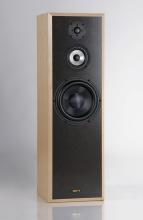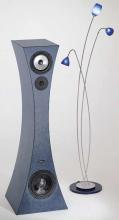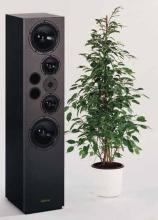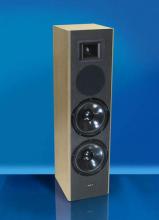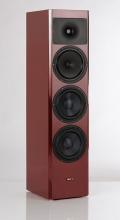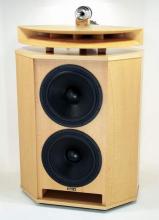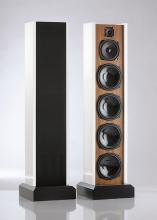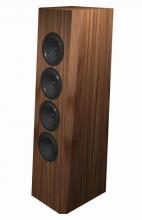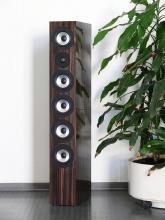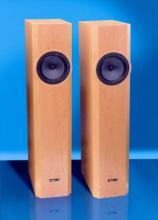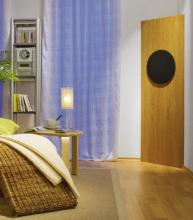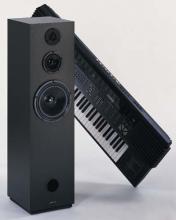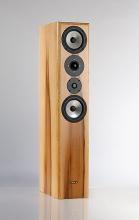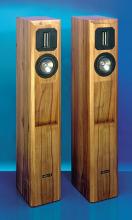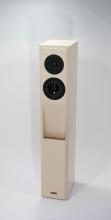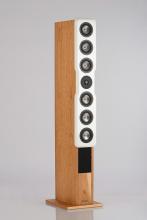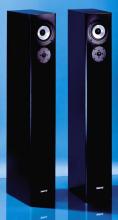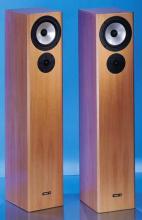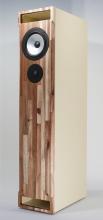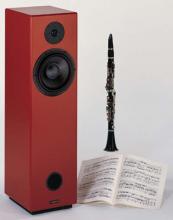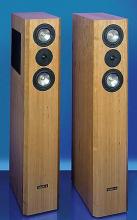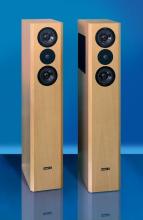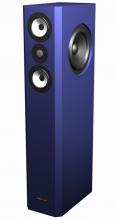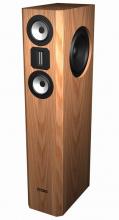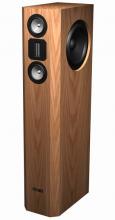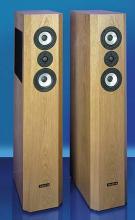Column Speakers
ALTO II
This 2-way column speaker, ALTO II, designed as a 30 litre vented system, is another suggested application from the Alto series. The same driver arrangement has been selected as for the ALTO I but, here, the lower range octaves benefit from the enlarged cabinet volume and optimum bass frequency to produce powerful, responsive bass.
ALTO II is also well-suited to improving the sound of low-priced compact hi-fi systems.
The ALTO II can be positioned freely anywhere in the room, producing clearly defined spatial sound character.
ALTO III C
The ALTO III c has been designed as a 3-way column speaker with an inside volume of no less than 44+3 litres. The twin bass arrangement using two W 170 S - 8 Ohm drivers in parallel guarantees very powerful low-ranging bass reproduction, that comes across crisply and impressively even with hard-hitting beat.
From around 450 Hz upwards, the 10 cm mid-range cone W 100 S - 4 Ohm takes over, mounted in its 3 litre enclosure. Single instruments and solo voices are reproduced throughout the mid-range in a most tangible, crisp fashion, where the precise definition of virtual sound sources and their associated range layering, so typical for good mid-range cones, comes across well.
Above about 3500 Hz, the sound character is rounded off neatly by the crisp 19 mm tweeter DT 94 - 8 Ohm. The exuberance demonstrated by the ALTO III c promises to put listeners in a good mood and keep them there for several hours of musical pleasure.The ALTO III c has been designed as a 3-way column speaker with an inside volume of no less than 55 litres. The twin bass arrangement using two W 170 S - 8 Ohm drivers in parallel guarantees very powerful low-ranging bass reproduction, that comes across crisply and impressively even with hard-hitting beat.
From around 450 Hz upwards, the 10 cm mid-range cone W 100 S - 4 Ohm takes over, mounted in its 3 litre enclosure. Single instruments and solo voices are reproduced throughout the mid-range in a most tangible, crisp fashion, where the precise definition of virtual sound sources and their associated range layering, so typical for good mid-range cones, comes across well.
Above about 3500 Hz, the sound character is rounded off neatly by the crisp 19 mm tweeter DT 94 - 8 Ohm. The exuberance demonstrated by the ALTO III c promises to put listeners in a good mood and keep them there for several hours of musical pleasure.
ALTO LINE MK II
The ALTO LINE MK II is a slim, 2-band column speaker with two 13 cm mid-bass units and one dome tweeter.
Due to its slim design and the correspondingly small footprint, this model is ideal as a free-standing speaker in smaller rooms.
The spatial separation is well handled by the speakers and can, as a result, produce clear sound characteristics even in "normal" living rooms.
The unusually broad range bass spectrum for a speaker of this size, that remains crisp even at higher output levels, is a point worthy of note.
As a result of its balanced, crisp sound characteristics, and the finely detailed, exuberant high-frequency output, the ALTO LINE MK II can be considered a fully-fledged member of the ALTO speaker family.
ATLANTIS MK II
The ATLANTIS has been consistently designed for optimum sound-pressure rating while retaining a moderately sized cabinet and an elegant appearance. In the bass range, two AL 170 - 8 OHM are mounted in parallel but in separate housings, where each has about 27 l of air space to itself. These speakers have a lower limiting frequency of 28 Hz meaning that they generate good, solid deep bass. Where you position the speakers is more or less a matter of choice, but they should not be right against the wall (a minimum of 10 cm is needed) as otherwise the effect of the bass reflex tubes will suffer.
Compared with the 'normal' AL 130 - 8 OHM, the AL 130 M - 8 OHM is equipped with a shorter voice coil. This improves efficiency and makes it the ideal choice in this combination.
Used as a tweeter, the KE 25 SC - 8 Ohm is activated from 2500 Hz. The distortion factor of this ceramic dome driver is really low at these frequencies, so that even high volume levels come across completely free of distortion.
ATLAS COMPACT MK V
The 5th generation of VISATON's classic ATLAS COMPACT is positioned in the mid- and high-ranges and compares with the systems mentioned at the beginning of the series. Once again, we have the DSM 25 FFL - 8 Ohm and DSM 50 FFL - 8 Ohm dome loudspeakers. The low- to mid-range is covered by the AL 170 - 8 Ohm. What is new in this version is the TIW 300 - 8 Ohm as the woofer.
The crossover, too, has been thoroughly reviewed. The separating frequency between the woofer and low- to mid-range unit has been set at 220 Hz. Thanks to this relatively low separating frequency, the bass is particularly powerful between 50 and 100 Hz. This is accompanied, however, by a reduction in impedance in this range of frequencies. There is compensation for the increased impedance in the woofer (KN 27 mH, 330 µF) which prevents this low impedance curve, but this also reduces the bass output level at 80 Hz by around 3 dB (red line below 100 Hz). This can be a great advantage in rooms where the bass output level is boosted excessively by resonance. Where the output level is more important and a reduction in nominal impedance at 80 Hz to 4 ohms is acceptable, the impedance compensation is simply deactivated to produce the higher frequency graph. In this way, the ATLAS COMPACT MK V offers a tangible advantage in that the bass output level can be trimmed to suit the listening room.
The broad chamfers in the upper part of the baffle give the cabinet a slimmer appearance while, at the same time, avoiding the build-up of corner reflection in the sensitive mid- and high-ranges.
The ATLAS COMPACT MK V is a very dynamic speaker with powerful bass reproduction but without getting woolly in the bass department. Additional features are absolutely neutral voice reproduction and crystal-clear high-frequency sounds without sharp edges.
CASABLANCA III
The first thing one notices about the CASABLANCA III cabinet is its striking design. This cabinet shape, however, has more than just eye-catching qualities, its acoustic qualities have to be heard to be believed.
The speaker consists of a large lower chamber and a top-mounted upper chamber and the two are interconnected through an opening that has been exactly calculated. This is, in fact, a twin-chamber vented cabinet. As a result of the twin-chamber arrangement, it is possible, in comparison with a conventional vented cabinet, to extend the range downwards by a considerable amount. The Helmholtz resonance of the upper chamber is around 90 Hz, that of the lower chamber around 33 Hz.
The fibre glass high-end GF 200 - 2 x 4 Ohm woofer has been used in the CASABLANCA III and helps achieve unbelievably low-range bass levels and, at the same time, producing remarkable maximum volume levels for a speaker of this size. The two tried-and-tested "softening" textile dome units G 50 FFL - 8 Ohm and G 25 FFL - 8 Ohm guarantee transparent, rounded sound qualities across the entire mid- and high-range. The convex cones also blend in well with the overall design of the CASABLANCA III model. The result is an unusual speaker both as regards its design and its construction principles with excellent low-range bass reproduction coupled with tremendous signal fidelity.
Not available as a complete kit.
CASABLANCA MK IV
The first thing one notices about the CASABLANCA IV cabinet is its striking design. This cabinet shape, however, has more than just eye-catching qualities, its acoustic qualities have to be heard to be believed.
The speaker consists of a large lower chamber and a top-mounted upper chamber and the two are interconnected through an opening that has been exactly calculated. This is, in fact, a twin-chamber bass reflexcabinet. As a result of the twin-chamber arrangement, it is possible, in comparison with a conventional bass reflex cabinet, to extend the range downwards by a considerable amount. The Helmholtz resonance of the upper chamber is around 90 Hz, that of the lower chamber around 33 Hz.
The woofer in the CASABLANCA IV is the AL 200 - 8 OHM, which is so popular among connoisseurs of high-end technology. Thanks to its long-stroke woofer, the AL 200 - 8 OHM helps the CASABLANCA IV achieve unbelievably low-range bass levels and, at the same time, producing remarkable maximum volume levels for a speaker of this size. Another "first" in this model is the two tried-and-tested DSM 50 FFL - 8 OHM and DSM 25 FFL - 8 OHM titanium dome units, that guarantee transparent, rounded sound qualities across the entire mid- and high-range.
Results: The result is an unusual speaker both as regards its design and its construction principles with excellent low-range bass reproduction coupled with tremendous signal fidelity.
CLASSIC 200
As the name CLASSIC 200 suggests, this speaker design uses the classic 3-band arrangement: one woofer, one mid-range cone and one dome tweeter, all arranged one above the other close together in the front baffle. The AL 200 - 8 Ohm, TI 100 - 8 Ohm and KE 25 SC - 8 Ohm used here are the best drivers in their respective categories available from the VISATON catalogue. For an upright cabinet, this is relatively small, enabling space-saving use in almost any sitting room.
The sensitivity of the CLASSIC 200 is excellent for a speaker of this size. This is made possible by the "slim-line" bass tuning. In comparison with the VOX 200, which has almost the same driver arrangement, the lower limiting frequency has been set slightly higher. This will appeal in particular to those who appreciate more "crisp" bass reproduction. The difference is that, in the CLASSIC 200, the low-frequency room resonance which is almost always present in any room, is not excited to the same degree and this reduces the reverberation.
The other drivers are also without doubt excellent and contribute to a holistic overall sound consisting of precise mid-range and clear as crystal, unobtrusive, smooth-as-silk treble frequencies.
CLASSIC 200 GF
Visaton's CLASSIC 200 GF offers an interesting way to enter the world of high-end music pleasure. The high-quality components have been selected with an eye on optimising value-for-money but without losing sight (or rather, sound) of the key quality requirements.
Supported by the front bass reflex vent, the GF 200 - 2 x 4 Ohmgenerates low-frequency sound in a classic 3-band combination. Thanks to the extremely rigid fibre-glass diaphragm and long cone-displacement properties, level accuracy is perfectly maintained even when coneexcursion is considerable.
In the mid-range, the TI 100 - 8 Ohm, one of the best Visaton drivers available, takes control. This very light, rigid titanium driver has become a reference point in terms of distortion free, well-detailed music reproduction.
Above 2200 Hz, the G 20 SC - 8 Ohm fabric dome driver cuts in and does not stop until well above the frequencies considered to be audible (30 kHz).
The overall result is a very high-quality, perfectly balanced speaker whose moderate size makes it an excellent candidate for enjoying high-end music in the sitting-room.
CLOU
The CLOU is a slim-line 2-band column speaker offering real value-for-money as a key feature, as shown in the choice of two WS 17 E - 8 Ohmfor the low-to-medium frequencies and the SC 10 N - 8 Ohm for the higher frequency range. To guarantee balanced overall sound quality using these less-expensive drivers, the two mid-bass units are physically separated from each other and each has its own enclosure. The lower WS 17 E - 8 Ohm is mounted in a 36-litre compartment. This produces a uniform increase in the frequency response from 60 Hz up to 600 Hz. The upper WS 17 E - 8 Ohm, on the other hand, is mounted in a smaller 16-litre compartment, which causes a slight increase in the range of frequencies between 60 Hz and 150 Hz. However, taken jointly, the two mid-bass units create a harmonious bass foundation which deliberately emphasises the frequencies between 60 Hz and 130 Hz. To ensure a seamless transition between the tweeter and the bass drivers, you need a properly balanced damping circuit to cut out any unwanted peaks and resonance.
The result of this unusual combination of drivers and cabinet is a column speaker that has to be seen and heard to be believed and one which produces a sound quality well above its moderate price range.
CONCORDE MK III
The CONCORDE MK III 3-way system may not be able to fly, but in terms of sound, it really soars. The mere shape and the drivers used give an idea of its qualities. The tailored baffle in the medium to high-frequency range produces optimised omnidirectional sound distribution one of the reasons why the sound distribution throughout the room is so smooth. Arranging all the drivers according to the D'Appolito principle, reduces interference from floor and ceiling reflection. Two AL 200 - 8 Ohmaluminium bass drivers join forces to produce profound and yet precise bass reproduction thanks to the extra-large, flow-optimised bass reflextube. The two AL 130 - 8 Ohm mid-range speakers guarantee crisp mid-range sounds as a result of their stiff cones, long stroke and impedancecontrol ring.
At the top end of the frequency range we have used the innovative KE 25 SC - 8 Ohm ceramic tweeter, which has been incorporated using a sophisticated crossover arrangement to optimise timing. This sophisticated design of tweeter can be wired up to blend in from a very low level and, as with all the other drivers, produces extremely distortion-free sound even at high volume settings. Any defects in the source signal are laid wide open. Even at louder settings, listening to music remains a real pleasure. This is always a good sign that the baffle is working correctly and that nothing is being smuggled in that should not be there.
In the MK III version, the cut-off frequency between the low- and mid-range has been shifted from 500 Hz to 300 Hz. The filter of the tweeter has been changed to 18 dB/oct additionally. That causes a more evenly sound radiation at different angels. This is especially noticeable in less damped rooms.
The completely neutral tonality and the remarkable dynamic characteristics of this stand-up CONCORDE MK III cabinet make it an all-round talent for discerning listeners of all types of music.
CONGA
With its CONGA Visaton has produced a "big brother" to accompany the classic 3-band combinations such as the CLASSIC 200 or CLASSIC 200 GF. With a cabinet volume of 85 litres and the 25-cm subwoofer drivers mounted on the front, this column speaker is an impressive eye-catcher.
The external appearance is underlined by the solid bass foundations provided by the TIW 250 XS - 8 OHM. This high-end woofer masters the art of powerful, responsive surges of bass just as efficiently as more restrained and subtle bass accompaniment.
The AL 130 M - 8 OHM, the specially modified version of the popular AL 130 - 8 OHM designed to produce higher sensitivity in the mid-range, continues the virtually linear frequency response seamlessly at a high level.
The KE 25 SC - 8 OHM tweeter, which cuts in at 3500 Hz, has no difficulty at all producing brilliant, crystal clear treble, even at high volume levels, which is why this ceramic dome driver is so ideally suited to rounding off the upper end of this powerful 3-band combination.
Well aware that the following statement may polarise opinions: the CONGA speakers are real men's speakers.
ELEVATION 3
This designer speaker cabinet is a challenge for any experienced craftsman who is looking for a speaker that stands out from the crowd. The excellent design means that the shape is not just a designer's whim but a technically thought-out reality. The front baffle has been kept as narrow as possible all the way along. This projects the sound away from the speakers into the room, in such a way that the instruments and voices are perfectly positioned and - provided the speakers are positioned away from the walls - the listener is treated to excellent spatial sound. The curved shape of the side panels has a stiffening effect and reduces resonance dramatically. In this way, the conventional reinforcements are not required.
In the bass department, we have the GF 200 - 2 x 4 Ohm with its high level accuracy, which can really make the most of its long-stroke voice coil and fibre-glass reinforced cone. The bass driver is positioned very close to the floor of the cabinet, and requires a low cross-over frequencyup to the mid-range. In order to maintain the excellent level accuracy here, a speaker with a large cone surface area has been chosen. In this combination, the AL 170 - 8 Ohm demonstrates its remarkable mid-range characteristics that guarantee exceptional transparency and clarity of sound. The tried-and-tested G 25 FFL - 8 Ohm textile dome unit adds depth and vitality to the high-range.
Not available as a complete kit.
EXPERIENCE V 20
The EXPERIENCE V 20 is a 96 litre vented cabinet and features a bafflearrangement based on the D'Appolito principle arranged symmetrically around the tweeter. In order to suppress any unwanted interference by the front baffle on the radiation pattern, the entire mid- to high-range unit is not positioned in the middle of the cabinet, but towards the inner side.
The woofers in the EXPERIENCE V 20 are two W 200 S - 8 Ohm 's in parallel up to around 450 Hz. From here, the mid-bass unit takes over. The W 130 S - 8 Ohm 's, also connected in parallel, cover the mid-range frequencies up to around 3000 Hz and hand over to the G 25 FFL - 8 Ohm textile dome unit at the high-range.
The crossover unit is designed for bi-wiring.
The very first impression you get of this V 20 speaker system will demonstrate the unrestricted exuberance the speakers are capable of. At the lower octave levels, the two 20 cm woofers produce crisp bass sounds with a dynamic punch that is unusual for speakers of this size. The mid-range produces absolutely linear, undistorted sound and the overall effect is of tangible sounds, spatially separated from the speakers themselves. The crystal clear, airy high-range reproduction from the 25 mm textile dome unit puts the final touch to the upper frequency end.
FIESTA 25
The strength of horn speakers is, without doubt, in their dynamism. Even short, extremely high peaks and sustained high volumes are reproduced without effort because horns are able to convert electrical energy into sound energy very efficiently. In many cases, this benefit is impaired by the fact that the sound is slightly distorted. This is not the case with the FIESTA 25. Emphasis has been placed in this development on achieving a frequency response curve which is as linear as possible - a key requirement for undistorted sound reproduction and a joy to listen to even if the listening session carries on into the small hours. In order to keep the cabinet down to a reasonable size for living rooms, the bass department does without a tube and instead uses large diaphragms in twin W 250 S - 8 Ohm in a closed compartment.
The striking feature of the FIESTA 25 is the mid-range horn. Here, the DK 8 P - 100 V/15 W horn speaker, based on the pressure chamber principle and borrowed from the public address department, has been applied as a low-impedance version (without the 100 V transformer). It differs from the many other horn speakers of this type which are available on the market by its remarkably good characteristics in the mid-range from 500 to 5000 Hz. Consequently, it is only applied within this range. The tweeter is the HTH 8.7 - 8 Ohm constant directivity horn which has already proved its worth in the MB 208/H kit proposal.
This unusual combination being rather quirky, it was necessary to devise a smart crossover design to achieve the high demands placed on the speaker and satisfy even HiFi standards. Even though the frequency response cannot be as linear as it would be with other loudspeakers, the listener is rewarded with remarkably good sound quality. The FIESTA 25has a pleasant sound ranging from low bass through the clear, well-defined mid-range up to the finest of the higher frequencies. In contrast to standard HiFi speakers, however, this one can easily produce extremely high peak levels and is quite happy to make the walls bulge with continuous, high-level volumes. Provided the listener takes up a suitable central sitting position between the speakers, the well-controlled directivity of these tightly bundled horn speakers allows well-recorded sound to be easily located while ensuring good range layering.
It is fair to say, then that this is a HiFi speaker which will provide very high levels of satisfaction.
GRAND ORGUE
The toughest challenge for a high-end loudspeaker is to reproduce the lowest frequencies of larger instruments, such as an organ or double bass, with appropriate fidelity. Only very few speakers are at all able to reproduce the lowest register of a church organ and even then only the very best are able to make it sound as if it was coming from an organ pipe. To do credit to a double bass in all its glory without sounding fluffy or over-inflated or, even worse, giving up altogether, is the reserve of very few, outstanding loudspeaker constructions. The "Les Orgues" speaker series, in this case the GRAND ORGUE species, represent exactly that capability. With eight WS 25 E - 8 Ohm woofers, optimised specifically as a free-air system, mounted in a folded, but open baffle, they are able to reproduce bass down to below 20 Hz in a most natural, unhurried and completely unexaggerated manner and with no sign of weakness. Since there is, in effect, no enclosure, the resonant frequency of the woofer is not increased, but in this case even decreased, which enables it to emanate clear, non-compressed extremely low frequencies. The precondition for this low-range bass imaging, which uses double-sided radiation, is, however, also to ensure the speakers are far enough away from the wall. One metre is sufficient, but for full power right to the bottom of the bass range, 2 - 3 metres is preferable.
But the effortless and unobtrusive deep bass is not all, by any means. The bass section, which radiates to both sides, is supplemented by a line array consisting of eight oval SL 713 - 4 Ohm full-range drivers. This moderately priced full-range loudspeaker is characterised by its extremely light paper diaphragm and the voice coil carrier made of kraft paper which, together, ensure absolutely natural sound right through to the highest frequencies.
A key characteristic of line arrays is that they generate a highly focused sound beam in the vertical plane. Outside that main path, a large proportion of the signal is cancelled out by interference. This prevents reflections from the floor and ceiling from even coming into existence, which would impair the precise tridimensional imaging of the music. However this beaming effect is a direct function of the wavelength of the sound radiated. The higher the frequency, and, as a result, the shorter the wavelength, the more extreme the beaming effect. A large array such as we have here in the GRAND ORGUE would normally lead to very extreme beaming in the high-frequency range, which would not reflect the reality of the sound being played. To achieve as uniform a beaming effect as possible across the entire frequency range, which is important to guarantee balanced sound quality in the listening room, we have arranged for a correcting circuit within the array. This circuit ensures that, as the frequency increases, additional output is directed towards the second and third full-range drivers from the top while the output to the other six drivers is gradually reduced. In effect, the array is shortened across the full range steplessly from eight loudspeakers to two. These two loudspeakers should be as close as possible to ear height. If ear height should actually be higher or lower than the midpoint between the second and third full-range drivers from the top, the system can easily be adapted to the situation by wiring up the array in such a way that e.g. the third and fourth drivers from the top are responsible for the higher frequencies. In this way, the cabinet can be tuned in small steps to suit the real situation.
Combining all these technical sophistications in a single cabinet results in an exceptional speaker system which is predestined for the "natural" reproduction of music, but not only for that. Whether it is a keenly picked guitar string, a crisp drum solo, an entire symphony orchestra including an uplifting, heart-warming string section and a powerful brass department, or the veritable queen of all instruments, the organ, it will all come across absolutely authentically, with dynamism and is guaranteed to give you goose pimples. In the same way, voices, male and female, are reproduced faithfully including every tiny detail. Each instrument and voice appear to be hovering in exactly the right place in space, the spatial quality is completely natural and everything is in the defined position.
Anyone on the lookout for loudspeakers for high-quality music, who does not intend to make compromises in terms of frequency response and who is keen on extremely accurate imaging of the stage or orchestra pit, should take a close look at the GRAND ORGUE. The only preconditions are a powerful amplifier and generous distances between the cabinets and the walls to enable the GRAND ORGUE to develop its capabilities.
HINT: The bass part of the GRAND ORGUE, on its own without the full-range drivers, connected directly up to an active source without a passive crossover, acts as an excellent subwoofer and can be used, either singly or as a pair, to support music-orientated high-end loudspeakers and full-range loudspeakers down to the lowest bass frequencies and give home theatres the bottom end that they deserve.
LA BELLE
The basic concept, as simple as it was ambitious, that lay behind the creation of the La Belle speaker was to define a perfect speaker system with no measurable or audible weak points in any test discipline and that would, as a result, ensure maximum listening pleasure in any room and with any music. To achieve this aim, a number of factors had to be taken into consideration, the most important of which were linear frequency response along the axes and across a certain angle coupled with minimum distortion, even for higher dynamic peaks.
A crucial factor in this respect is the choice of the right drivers. To obtain supreme large-signal behaviour in the bass it is necessary to provide an expansive diaphragm area in connection with long cone strokes. In this respect, there was no real alternative but to opt for the extremely long-excursion TIW 200 XS - 8 Ohm driver. Mounted as a pair, these two woofers on each side even out-do the TIW 300 - 8 Ohm, and have the added advantage that they require less space and thus enable the speaker columns to be built as a remarkably slim unit with the bass drivers in the front panel.
Thanks to the absolutely inexhaustible volume reserves inherent in these woofers and the specially adapted crossover, it was possible to dispense with a bass reflex arrangement to limit cone excursion. La Belle's base is, as a result, even more precise and clear and, depending on the room, go even further down the bass frequency scale than you would expect of conventional bass reflex speakers. To cater to dynamic mid-range frequencies with adequate diaphragm area there could be no better choice than the B 200 - 6 Ohm. Originally designed as a full-range driver, the B 200 - 8 Ohm boasts minimum mechanical losses and a light-footed, responsive mid-range. Protected against overly long cone excursions in the bass range and supported at the upper end of the frequency range by the tried-and-tested KE 25 SC - 8 Ohm ceramic dome driver, the B 200 - 6 Ohm in this combination excels itself and leaves nothing to be desired.
The tweeter, in cooperation with the Waveguide WG 220x150, displays qualities undreamed-of. Thanks to its optimised directivity, the ceramic dome driver in the Waveguide can ideally by linked to the large mid-range driver, which ensures an absolutely homogeneous, seamless unit. Even at the crossover between the mid-range driver to the woofers, there is no gap in the beaming effect, which is why the frequency response for the entire speaker unit is wonderfully linear not only along the axes but also at various angles. In addition, the separating frequencies have been selected in such a way that each branch covers a similar band of frequencies, which minimises annoying intermodulation distortion.
A listening test will confirm that this concept is an unqualified success - in creating La Belle, we have made a loudspeaker that has not the slightest weak point and reproduces any musical material with such authenticity and accuracy that one soon gives up trying to detect a flaw and just enjoys the music at a quality level as yet unknown.
The peculiarities of the individual room are far less significant than with most other loudspeakers. Thanks to its steady directivity, La Belle sounds equally as good in heavily damped rooms as in poorly damped, modern living environments. The good, solid deep bass is not excessive in smaller rooms thanks to the enclosed compartments but, on the other hand, is not inhibited by large rooms and high volume levels and is happy to descend into the deepest of low-frequency regions. Finest-quality high and medium frequencies combine to create a virtual stage which is presented to the listener as firm as if cut in stone and well differentiated, irrespective of the pitch. La Belle's special fascination is in the extremely broad dynamic range covered. Even at very low volume levels, it projects instruments and voices realistically and tangibly into the listening room and yet retains such a degree of lightness and fidelity, even at very loud volumes beyond the threshold of pain, that listening to is not wearing.
La Belle is, then, definitely the recommendation for demanding listeners who wish to rediscover their entire music collection and do not want to have limits imposed on them by the loudspeakers.
MONITOR 890 MK III
It is well-known that there are two types of loudspeakers: hi-fi speakers that produce the most accurate, unaltered sound possible, and disco or musician's speakers, where the top volume level is of the utmost importance. These volume levels are normally only possible with horns but these often cause coloration of the sound. The MONITOR 890 MK IIIwas designed specifically to combine the best of both worlds. In the mid-range, we use a driver & horn unit which is so dynamic and produces such undistorted music, that many a horn-disparager has had to admit that this is simply unbelievably "different". Two excellent quality woofers, TIW 300 - 8 Ohm, mounted in the 180 litre vented cabinet, generate a bass sound pressure that is physically tangible, as you have experienced with concert speakers. Combined with the first-rate TL 16 H - 8 Ohm high-range horn, we have created a loudspeaker system that breaks down the previously unbridgeable barrier between the hi-fi and the professional speaker.
The output levels of the mid-range driver and tweeter can be adjusted to the requirements of the locale using output controls. We recommend, initially at least, the following level settings: tweeter: -4 dB; mid-range: -4 dB. These can, of course, be adapted to suit the specific acoustics in the room and personal preferences.
Thanks to the added impedance linearising unit in the crossover unit, the Monitor 890 MK III is now even better suited to use with critical amplifiers (e.g. tube amplifiers).
NoBox 170
Electrostatic tweeters have maintained unbroken popularity for several decades. The large but light diaphragm, which radiates sound to both sides of the diaphragm, generates light, overall unfussy sound with excellent spatial qualities that is not attributable to a particular source and fills the room evenly with music. This type of speaker is generally extremely complex to manufacture and, as a result, not easily affordable. However, it is possible to create a sound experience very similar to this using conventional cone speakers mounted in an open baffle.
For the NoBox 170, four high-grade WS 17 E - 4 Ohm bass drivers with paper diaphragms were selected that are optimised for free-air use. Due to the fact that they have no cabinet, they produce wonderfully clean low-frequency bass. Also, thanks to the dipole principle, they generate fewer standing waves, which means the bass tends to fade more quickly, so it can never become fuzzy and does not drone. On top of this, there is the WS 13 E - 8 Ohm mid-range driver that also features a paper diaphragm and a high quality standard, making it ideal for free air use. In order to maintain the same standard of visual appearance, acoustic quality (and to stay in a moderate price range) paper diaphragms have also been used for the tweeters. The TW 6 NG - 8 Ohm provides a fitting finish with finely detailed, clearly defined high-range frequencies to ensure the soundproduced by the NoBox 170 is a harmonious whole. Since the tweeter is the only driver that is closed at the rear, a second driver is mounted back-to-back to emulate the dipole principle right through to the higher range. The level can be regulated and even switched off via a potentiometer. In this way, the tonal balance and the depth of the stage can easily be adapted to suit the actual listening environment and personal preferences. It is important to place the NoBox 170 at a sufficient distance from the rear wall to allow the considerable low-frequency bass to develop and so as not to restrict the depth of the stage layout.
Once correctly positioned and set up, the sound experience is fascinating: the NoBox 170 reproduces voices and instruments in the centre of the room with an airy lightness without artificially inflating them or shifting them laterally or in terms of depth. When seated in the middle of the listening space, the listener is treated to excellent clarity, but even in the seats right at the fringes of the space, the overall sound quality does not break up but remains faithful to its position and lively character in the room. Listening pleasure with the NoBox 170 is unusually stressless, the tonal balance and large-format diaphragm ensure superior performance down into the deepest bass regions of a standard one would not expect from such a small-sized speaker.
Anyone looking for a speaker arrangement with plenty of diaphragm area that can import a special atmosphere into the sitting room as a full-rangedipole, close to the results produced by large electrostatic speakers, should look at - and listen to - the NoBox 170 very closely.
PENTATON BB
Full-range loudspeakers are enjoying another comeback and arousing increased interest, embodying, as they do, everything that a point soundsource should be. Large full-range loudspeakers like the B 200 - 6 Ohmhave the additional characteristic of transmitting the sound in a tightly bundled beam, which produces a very tangible, three-dimensional effect and allows individual instruments to be easily located. A drawback of the system, however, is that this beaming process and the sensitivity are reduced at lower frequencies. The PENTATON BB was developed specifically as a cabinet based on the legendary B 200 - 6 Ohm but designed to compensate for these two disadvantages.
In a similar way to the QUADRO, additional full-range drivers are switched in to supplement the central driver, which is connected direct to the amplifier without an intervening filter, as the frequencies go down the scale. This allows the B 200 - 6 Ohm to develop its full potential with none of the impairments caused by frequency-dependent signal-carrying components, while the BG 20 - 8 Ohms, that are optimised for low-frequency response, maintain the extremely high sensitivity and beaming effect right down to the bass range. The additional full-range drivers are arranged symmetrically in two groups around the main speaker, which again creates an acoustic focus in the centre of the speaker cabinet. On top of this, the baffles in enclosures 2 and 4 and in enclosures 1 and 5 are angled inwards by 6° and 12° respectively. This feature guarantees that, assuming a typical listening distance of approx. 3 m, each of the drivers is exactly the same distance away from the ear and at the same angle. Given the size of these speaker cabinets, this is the only way to ensure that the phases of all the drivers are in sync across the entire frequency range.
The result of all these characteristics taken together is a sound image of the stage that could hardly be clearer or more precise. Even baritone male voices and large instruments such as the double bass or bassoon appear to be present full-size, in the right place on the virtual stage and in tangible 3D. Thanks to the enormous diaphragm area and the low moving mass, the PENTATON BB transforms dynamic jumps in the recording decisively and seamlessly into sound pressure and, with its superior handling, encourages the listener to increase the volume level until it is physically felt and yet it never becomes obtrusive or laboured.
And yet, this is definitely a speaker for connoisseurs of lower volumes. Even at low output levels, the overall sound quality is tangible and mature so that every tiny musical detail, however small, is projected audibly without the slightest distortion. The frequency response is remarkably linear for a loudspeaker of this kind, which is why the PENTATON BB is ideal for the authentic reproduction of every genre of music without restriction and will allow the listener to rediscover even old favourites thanks to its analytical and highly detailed approach.
Thanks to its high sensitivity and uniform impedance curve, the PENTATON BB is predestined for use in connection with high-grade tube amplifiers with relatively low output wattages.
QUADRO
When the QUADRO was developed, the primary objective was to produce a loudspeaker with a very high sensitivity rating because the trend in recent times has been a retrograde one towards high-end tube amplifiers. However, these are often restricted to very low outputs of only a few watts. There are plenty of loudspeaker constructions which promise extremely high volume levels with only one watt but, on closer examination, are seen to produce that level only at medium and high frequencies. Extending the high sensitivity level to include low frequencies is indeed a challenge. To achieve that aim, it is crucial to include a very large diaphragm area which, in turn, requires a large sized cabinet if one wants decent bass volumes.
The generously sized enclosed QUADRO cabinet provides sufficient space for four of the excellent B 200 - 6 OHM full-range loudspeakers to ensure that, even at the lower end of the bass frequency range, there is plenty of cone excursion. The drivers are closely bunched one above the other, which provides for an excellent radiation pattern: a broad angle in the horizontal plane and a relatively tightly bundled beam to top and bottom. To prevent the bundling effect becoming too strong in the vertical, all the drivers are powered in parallel in the bass frequencies and, as the frequency increases, the B 200 - 6 OHM 's are phased out one after another so that, at very high frequencies, only the second driver from the bottom is working. The slightly tilted front baffle means that this full-range loudspeaker is then aimed directly at ear height, assuming one is seated at least 3 metres from the speakers.
Anyone with experience of the sound properties produced by the SOLO or SOLITUDE speakers will have a fairly clear idea of the clarity of soundproduced by the QUADRO. These qualities are, however, boosted by the fact that the air in the room is set in motion by a large diaphragm area but that force is hardly aimed at the floor or ceiling at all. A noticeable feature of the QUADRO are its clarity and analytical qualities, while, at the same time, not becoming obtrusive. The QUADRO may not be able to match the extremely deep bass output levels of the SOLITUDE, for example, but that is in fact a positive feature in rooms that are not so large because the reverberating room resonance frequencies are not stimulated at all. However, the physically tangible kick-bass effect, a feature expected from musicians' speakers, can indeed be produced if the amplifier is powerful enough. In addition, the QUADRO shows its strengths in the faithful reproduction of voices and recordings of large orchestras. It is fair to say, then that this is a good, all-round high-end loudspeaker.
QUINTETT
With a cabinet volume of just over 56 litres, the QUINTETT could not be said to be a small speaker. Despite its size, it comes across as elegant and sophisticated, thanks to the arrangement of its drivers and the slim baffle. Fitted with no less than five AL 130 - 8 Ohm, it is generously equipped but stopping short of exaggeration.
Four of the AL 130 - 8 Ohm, with a combined diaphragm area of 316 cm², are fitted in the bass reflex cabinet and generate sufficient bass, so no subwoofer is needed. The QUINTETT is based on a development idea suggested by the German "Klang & Ton" Hi-Fi magazine which was then finalised by modifying the crossover.
The uppermost of the five AL 130 - 8 Ohm, which is neatly housed in its own enclosed 5-litre cabinet, together with the tried-and-tested KE 25 SC - 8 Ohm ceramic dome tweeter, produce clear mid-to-high-range soundabove 500 Hz.
In terms of its sound quality, the QUINTETT can be described as rich in detail and very precise. It uncompromisingly shows up every defect in a recording but, on the other hand, reproduces good recordings perfectly, without the slightest distortion and with remarkable positioning accuracy. Bass sound is reproduced very accurately and clearly and, thanks to the be-wiring connections, can be controlled separately from the mid- and high range frequencies. The QUINTETT is, as a result, not a speaker that produces some softened-down mash, it is, on the contrary, a realist that can easily cope with maximum volume settings.
QUINTETT LIGHT
Just as the light versions of VOX and COUPLET, the QUINTETT LIGHTis aimed at coming as close as possible to the outstanding sound quality of its "big sister", with substantial lower priced driver units.
When listening to both the QUINTETT and the QUINTETT LIGHT, the direct comparison attests: Goal reached.
The QUINTETT LIGHT is, as well as the QUINTETT, a high efficiencyspeaker with a very balanced frequency response. Only in terms of dynamics and maximum sound pressure level, the QUINTETT LIGHTcannot fully keep up with the outstanding performance of the QUINTETT.
Anybody who is into the concept of the QUINTETT, but at a more favourable price, is well advised to take a closer look at the QUINTETT LIGHT.
SOLITUDE
The SOLITUDE set-up combines the direct, highly precise soundreproduction of the B 200 - 6 Ohm wide-range speaker with the dynamic bass of two GF 200 - 2 x 4 Ohm. The B 200 - 6 Ohm is fitted in a completely enclosed, heavily damped compartment. The two GF 200 - 2 x 4 Ohm woofers are mounted in a voluminous cabinet with a generously dimensioned bass reflex tube. Owing to the very low-frequency separation, SOLITUDE is, in effect, a wide-range speaker with a subwoofer.
First impressions: fantastic sound! A synthesis of the precision localisation, clarity and analytical precision of the SOLO 100 or SOLO 50(straight down the axis) and the level accuracy of the CONCORDE MK III. The bass is deep but not heavy, the medium range clearly evident, with no fuzzy fringes. We could not detect a break between the bass and the rest - the sound was more homogeneous and pure than we had ever heard from any other wide-range speakers.
The two sections have to be reverse connected. In so doing, it does not matter whether the bass is connected correctly or not as long as the SOLITUDE is playing on its own. In conjunction with other speakers (e.g. in a multichannel system) the bass must, of course be in sync.
SOLO 100
The B 200 - 6 Ohm was fitted in a narrow column speaker with a net volume of around 100 litres. Due to the high Q-factor, one would normally have a relatively strong increase in reverberation response at around 60 Hz in a normal enclosed chamber or bass reflex cabinet. To prevent this, and indeed to take full advantage of the bass reflex principle, we thought up this little arrangement which, to our knowledge, has not been done before.
The chamber is split into two equal parts by a separator. On the rear wall, we built a vertical tunnel as a Helmholtz resonator which was tuned exactly to the frequency of the increase. This tunnel was then loosely filled with a packing of wool. In its undamped state, this resonator absorbs just the amount of the increase and even causes a slight dip in this range. You can vary the amount of packing used to achieve the required frequency response. In this way, we managed to ensure that the bass reflex did not produce overpowering bass despite the bass reflex tuning.
In keeping with the frequency response so typical of wide-range speakers with increasing medium- and top-range frequencies, this speaker, too, has an unacceptably high-pitched sound. So we applied a passive correction circuit (five simple components) to smooth off the frequency response in a very simple but effective manner for a full-range loudspeaker. Depending on the acoustics in the room and personal preference, the 15 ohm series resistance can be changed. Reducing it to 10 ohms will result in an increase in the high-frequency range, while increasing it to 22 ohms will dampen the treble more effectively.
SOLO 50
The SOLO 50 applies the SOLO 100 concept to a more compact cabinet. This makes the units suitable for smaller rooms where the larger version would be too physically overpowering or the bass too powerful.
With a net volume of 50 litres, it is essential to have an internal resonance absorber as with the SOLO 100 owing to the Q-factor of the B 200 - 6 Ohm. This can also be used to fine-tune the bass reflex. The lower limiting frequency is not as low as with the SOLO 100 but is certainly sufficient for small to medium-sized rooms. The absorber must be carefully damped again.
The correcting circuitry is designed by analogy to the SOLO 100. If you replace the 15 ohm resistance with a 22 ohm, the increase in high-frequency frequency response will be eliminated and the result as measured in the measuring room was a well-balanced spectrum. Listening tests showed, however, that, as a result of the beaming effect of this wide-range speaker, a slight increase is beneficial in most listening environments.
SOLO Eckbox
It is a physical characteristic of all wide-range high-sensitivity loudspeakers, and that includes the high-end B 200 - 6 OHM speaker, that they reproduce higher frequencies louder than the lower ones. To compensate for this, we have designed speaker cabinets for the corners of the room. Corners tend to boost the bass but not the higher frequencies. This allows us to use a very simple correcting circuit (consisting of a coil and a resistance) and we still get a very pleasing, natural overall sound.
With relatively little effort, it is possible to produce efficient, high-end speaker cabinets with excellent sound properties which also fit in optically. If you want to, you can even make them blend in completely or almost disappear by wallpapering them the same as the walls or painting them the same. The shape can even be adapted to take full advantage of the height of the room, for example. What matters is that the inside volume is kept the same.
A complete kit for this suggestion is available via www.vc-mailorderservice.de.
STARLET
The STARLET is a 3-way speaker which is extremely good value for money. The individual drivers used here have all proved their worth in numerous well-known constructions.
At the bottom end of the frequency range, there is the W 200 S - 8 Ohmfrom the EXPERIENCE V 20, mounted in a 58 litre vented cabinet. The mid- to high-range is covered by the W 100 S - 8 Ohm and DT 94 - 8 Ohm from the ALTO series of speakers.
The impression given by the STARLET is of a solid low-frequency foundation with powerful, crisp bass. The mid-range has a pleasant, unobtrusive sound, and at the higher frequency ranges the STARLETproduces sparkling, clear-cut treble. In a nutshell, the STARLET is an extremely reasonably priced column speaker with a well-rounded tonal character and good power handling capabilities.
STELLA LIGHT
To be clear from the start: these small sized STELLA LIGHT speakers pack a considerable punch. While the outer appearance of the speakers might be described as compact or even sweet, this definitely does not apply to the maximum sound pressure of which they are capable. The combination of universal full-range FRS 8 - 8 Ohm loudspeaker and W 170 S - 8 Ohm woofer stands out because of its unbelievable level accuracy.
The fact that the separating frequency is at a very low 200 Hz benefits the STELLA LIGHT's positioning accuracy and generates an image of the stage that easily earns the "live" label. The FRS 8 - 8 Ohm full-range loudspeaker is remarkably detailed in its output: even the higher frequencies are reproduced accurately and with clear focus. Complemented by the W 170 S - 8 Ohm woofer, this combination covers almost the full range of frequencies required.
Whether used as computer speakers to the left and right of the desk or as a stereo set for the sitting room or bedroom, thanks to the excellent value-for-money price, these speakers can be used universally in many different environments without making too large inroads into your wallet. The simple, effective and intriguingly designed series crossover rounds the system off to produce a low-priced, quality building kit.
After all the cables have been positioned in the cabinet, the cable opening in the divider will have to be sealed off with e.g. hot-melt glue.
SYMPHONIE
SYMPHONIE's sound profile can best be described as very mellow and melodious. The two AL 170 - 8 Ohm 17-cm woofers generate a full-bodied but well-defined bass in their isolated bass reflex compartments that one would not normally expect of a design such as this. Even at the lowest bass frequencies, SYMPHONIE retains its fidelity and produces clear, precise sound even at high volumes.
The highlight of the SYMPHONIE system is the 50-mm G 50 FFL - 8 Ohmmid-range dome. In the mid-range, it is this driver that ensures unbelievably tangible reproduction of the stage arrangement and provides clearer detection of the central (vocalist's) position than that provided by many other systems. Even recordings that are not perfectly spatial come across as well separated from the speakers, thanks to the SYMPHONIE. As a result, longer listening sessions become a source of relaxed long-term pleasure.
In the high-frequency range, the well-known ceramic dome driver, the KE 25 SC - 8 Ohm, is used to good effect and rounds off the overall soundpicture with its silky-smooth sound properties and outstanding linearity.
TOPAS
TI 100 - 8 Ohm and MHT 12 - 8 Ohm are clearly two of the best drivers VISATON has to offer. The Hobby HiFi editors developed the TOPASmodel on the basis of these drivers by combining them in a delicate-looking, unusual speaker cabinet and demonstrating that they do, indeed, harmonise together beautifully. Compared with the original Hobby HiFi proposal, we have now slightly modified the crossover in order to achieve a warmer-sounding effect which guarantees long-term, relaxed enjoyment. By modifying the inner damping, it has also been possible to simplify the housing and suppress resonance even more effectively.
It is not only the spatial effects and the accuracy of the separation that are impressive, the frequency response is also unusually broad. The upper limiting frequency is at 40 kHz which is well outside the audible range. The lower 35 Hz limit is remarkably low for a 10 cm woofer. This is achieved by fine-tuning the cabinet in the borderline area between vented bass and transmission line. Obviously, the small-diameter TI 100 - 8 Ohmcan only reproduce such deep bass at a limited volume level. The physical limits are dictated by the surface area of the diaphragm and the length of stroke. The TOPAS is, as a result, not intended for reproducing powerful rock music or action-packed movies. But it is surprising how often visitors say to us, after hearing a demonstration of really large, powerful speakers, "That's all very well. But at home I can hardly turn them up to that sort of volume anyway." The TOPAS has been specially designed for people like that. Small and homely but with bass quality that will have your visitors' eyes roaming the room looking for a hidden subwoofer.
The TOPAS will take loads of 40 / 60 watts measured using standard measuring techniques. This does not mean, however, that the amplifier can not have a higher output level than this. It is possible to use an amp with a far higher output than this provided you take it easy with the volume settings and do not turn up the volume to a level that causes distortion in the sound quality. TOPAS speakers should be kept out of the reach of small children and overtly merry partygoers.
TOPAS LIGHT
The LIGHT version of the TOPAS is, just like its larger sister, a speaker that is perfectly happy being run at low volumes. High volume levels are just as distasteful to the small 10 cm W 100 S - 8 Ohm mid-bass driver in this combination of cabinets as they are to the high-end TI 100 - 8 Ohm. This is a natural consequence of the small diaphragm area and limited excursion.
However, due to the large cabinet volume and the bass reflex/transmission line arrangement, this speaker produces a surprisingly rich bass sound that one would hardly expect to get from a 10-cm driver. This, in conjunction with the extremely reasonably priced SC 10 N - 8 Ohm tweeter and the few components making up the crossover, creates a small column speaker that must be generally affordable by anyone and will earn its fair share of astonished looks.
But how does this less expensive version compare in reality to the TOPAS? To be perfectly frank, the sound quality of the TOPAS is not quite matched. The LIGHT version is slightly lacking in detail and less precise compared with its big sister. The clarity of the TOPAS that was praised so highly by various specialist magazines cannot be equalled in a direct comparison. But if one bears in mind the price difference of around € 800, it is surprising how well the LIGHT version stands up for itself in terms of value-for-money.
This is our recommendation: this is the ideal speaker solution for people who prefer quieter sounds or for use in quieter listening areas, such as the bedroom etc. But anyone who is not averse to spending more and who needs to be able to squeeze more volume from the setup, will want to go for the more expensive TOPAS.
TRINITI
Six TI 100 - 8 Ohm and one KE 25 SC - 8 Ohm built into a hybrid cabinet design that combines horn and transmission line principles. In many respects, this is something special, something different. The development effort involved was particularly great. There has seldom been a project that required so much rebuilding and intensive optimisation. The development of the crossover was most complicated of all because there is powerful interaction in the bass department with the damping, so with each new configuration both had to be adjusted to match. The construction of these cabinets is aimed at particularly skilled cabinet builders, which is why we would emphasise that building them is a matter for DIYers with plenty of experience, this is not a good project for first-time builders. Alternatively, you can always commission a professional cabinet maker. The wiring is also not exactly a piece of cake, due to the sheer number of drivers used, but it can be mastered if you have a grasp of the basics.
Anyone with the confidence to attempt construction of this loudspeaker will be richly rewarded, in terms of both the visual appearance and the acoustic presence. Despite the impressive height of the speakers, the narrow front panel communicates a tremendous lightness – far more so than one would expect, given the sheer dimensions of the cabinets.
The hollow base of the cabinet houses the crossovers and raises the tweeter to the on-axis plane. The spacing of the drivers not only optimises the function of the cabinet but also assures a pleasantly harmonious appearance, while approaching a D’Appolito configuration.
Four of the 8 ohm TI 100 are exclusively assigned to the bass frequencies. With a total diaphragm area of the drivers equivalent to
20 cm, there is no need to worry about dynamic reserves and level accuracy. A further two 8 ohm TI 100 act as pure mid-range drivers, while the 8 ohm KE 25 SC dome tweeter takes up the central position both physically and acoustically. To prevent interference between the coils, the crossover has been split across two PCBs that are physically separate from each other. By connecting the mid-range speakers in series it has been possible to configure this branch without any resistances to balance the levels; only the tweeter requires a little restriction. The system has been designed using only essential components and, with the exception of the bass branch, it has been possible to dispense with remedial branches, which means the component requirements are on the modest side for a three-way speaker.
The separating frequency between the high and mid-ranges has been set at 2100 hertz, which is so low that, in conjunction with the slope rate of the 3rd order filter (18 dB filter), the baffle resonance levels of the 8 ohm TI 100 have no negative effects. Thanks to the highly linear sound pressure and impedance frequency response of the 8 ohm KE 25 SC ceramic dome driver, it is possible to create the link using a deliberately minimalistic 12 dB filter, allowing the driver to respond with the superb characteristics it was designed for. Also, by separating the mid-range and bass frequencies at a low 180 hertz, the designers have achieved a situation where the locatable frequencies emanate almost exclusively from the drivers for the mid- to high-range group that are close together. Furthermore, the tendency for bass horns to resonate in the mid-range has been minimised by filtering the critical frequencies through the crossover, so they are hardly excited at all in the horn. As a result, it has been possible to reduce the necessary damping considerably compared with a higher separation level, which benefits bass reproduction.
The pure reference-standard sound, without the slightest distortion, the fidelity of detail and clarity are breathtaking. Resolution of this quality is difficult to beat – every last detail is heard, nothing is suppressed or drowned out. But this does not mean that the details are obtrusive or heavy-handed, they are merely there. It may sound contradictory that the finest details are reproduced in the overall sound package but can still be overheard. It does require an active listening effort to detect them, quite simply because they are not artificially boosted or forced into the foreground but are rather presented to the listener in the best way as a perfectly natural component. On the other hand, it is not necessary to exert oneself excessively to pick up these nuances, they are audibly present and not just implied. This means that even very long listening sessions are not the slightest bit tiring. Vocals come across tangibly and seamlessly. Poor quality recordings are instantly detectable as such even for less well-trained listeners. There is no detectable colouration, the sound properties are analytical but not cold.
High frequencies are clear, fast and accurate but never intrusive or excessive. If the recorded material is the result of good mastering, it will shine and sparkle when it is supposed to and can easily cause waves of goose-pimples.
The dry, deep bass is surprising; the narrow cabinet and relatively small bass driver do not look capable of generating such a presence.
However, the bass is not thick or overpowering, it is precise and well-defined and is a refreshing rest from those boomy boxes that are currently so high on the best-seller lists.
The TriniTI should, however, never be underestimated. It is well able to move large quantities of air. When instructed to do so, the four 8 ohm TI 100 can project an unbelievable amount of deep bass energy into the listening area. Discerning listeners can experiment with the optional damping mats in the opening of the horn to fine-tune the bass to their personal tastes and the room. If one relies on the measurements, the best version is one in which the two optional pieces are inserted in the horns, but in our listening tests in the listening room we preferred the version without this option.
The level accuracy was a further surprise: the limit is well above volumes we would term "home use". It is particularly noticeable that the overall sound quality remains completely stable and effortlessly uniform across the full range from loud to quiet. As a result, dynamic leaps are reproduced faithfully and the stage does not collapse when things get a bit heavier. The TriniTI will always respond in a relaxed, measured way and present its maker with exactly the acoustic nourishment that is fed into it. To the detriment of neighbourly relations, there is a tendency to turn up the volume control, simply because the speakers show that they can take it. However, their strength definitely lies in their clarity and resolution. One seldom experiences loudspeakers that are as neutral as these, whose complete range of reproduction and volume levels always remains so well-balanced and yet is so incredibly responsive. Their precision and ability to produce result in tremendous satisfaction while never resorting to excesses or irritation. This means one can enjoy music at low volume levels but equally well at high volume levels. These loudspeakers are quite simply enormous fun.
VIB 130 TL
There are plenty of transmission line fans among the speaker-building fraternity. HOBBY HiFi recently developed a super-slim speaker with a folded transmission line (TML). The VIB 130 TL cabinet suggestion is based on that idea and uses an AL 130 - 8 Ohm and a G 20 SC - 8 Ohm.
This speaker cabinet works on the basis of an organ pipe. At one end is the driver while the other end is open. Certain frequencies generate resonance which causes particularly powerful sound reproduction at the open end. The longer this tunnel, the lower the frequency.
In order to make use of this principle for low frequencies, a length of several metres would be necessary which is only possible by "folding" the transmission line tunnel twice within the cabinet to achieve convenient dimensions, as integrated in the VIB 130 TL. Apart from the intentional low frequency resonance, TML's also generate interference resonance at higher frequencies. It is only by damping the space very carefully that the desired results can be achieved.
Two internal Helmholtz resonators are in use directly behind the woofer as sound absorbers and, in conjunction with the extremely carefully positioned damping material, will ensure that the frequency response is kept beautifully smooth.
VIB 130 TL solves the problem of reproducing low-frequency bass in small rooms where the speakers have to be positioned close to walls. A distance of 10 cm is perfectly adequate.
Real deep bass is not to be confused with disco bass, which one tends to feel through the stomach rather than hear. Deep bass is soft, smooth yet powerful. However, in order to produce such power with small speakers, there has to be a trade-off with the sound pressure. As a result, the efficiency of the VIB 130 TL is relatively low but still well able to cope with normal conditions. This is counterbalanced to a large extent by the extensive frequency response. The cleanliness of the sound picture produced is remarkable with well-placed spatial locations, especially when positioned near a wall. The 20 mm G 20 SC - 8 Ohm tweeter guarantees crystal-clear, lively high-frequency reproduction and provides a smooth upper end to the range.
VIB 170 AL
The VIB 170 AL is a slim-line 2-band column speaker using an AL 170 - 8 Ohm woofer and a 25 mm, G 25 FFL - 8 Ohm textile dome tweeter. The 34 litre bass reflex cabinet produces a remarkably deep lower limiting frequency of only 25 Hz, but maintains its powerful, precise bass reproduction. The reason for this is the subwoofer AL 170 - 8 Ohm with its rear-vented spider and its long cone strokes. The flow-optimised bass reflex tube BR 25.50 is mounted at the rear of the cabinet to present the most ideal optical appearance, but can, if the cabinets are to be set close to a wall (closer than 10 cm), be moved to the front without any loss in quality.
The two 1 µF capacitors in conjunction with the 2.2 mH coil form a blocking circuit that effectively suppresses the resonance in the aluminium diaphragm generated typically by that material.
The VIB 170 AL is a compact speaker with well-balanced sound quality and clean-cut bass and impulse fidelity, providing excellent dynamic properties for a speaker of this size.
VIB 170 BP
When developing the VIB 170 BP, the main objective was to create a fairly compact column speaker with an extremely deep bass output, which is capable of reproducing the deepest regions of the audible frequencyspectrum. A common bassreflex housing can reach this aim only partly. Therefore, a very rare type of cabinet has been realized, at least when looking at fullrange-loudspeakers: A double-sided ventilated bandpass. In this layout, a woofer which is mounted on an inner separation wall, is operating on two bassreflex-tuned volumes, a larger one and a smaller one. By means of a subtle tuning of the two cavities, a linear frequency response down to 35 Hz (-3 dB) could be obtained with a housing of only 75 liters. Not until then, the sound pressure level starts to drop rather quickly. The lower cut-off frequency (-10 dB) is located around 24 Hz. Some very large bassreflex speakers are capable of reaching similar cut-off frequencies, but the SPL already starts dropping at much higher frequencies. This is why those kinds of loudspeakers sound less voluminous and deep.
Due to the exceptionally high excursion limit of the TIW 200 XS - 8 Ohm, the maximum obtainable sound pressure level is already physically tangible and more than sufficient even for large listening rooms.
Another design feature of the VIB 170 BP is the wide frequency range of the AL 170 - 8 Ohm. By means of a sophisticated crossover set-up, we have been successful in taking advantage of the outstanding acoustical properties of the AL 170 - 8 Ohm from 100 Hz up to 8 kHz. Not until then, the established ceramic tweeter KE 25 SC - 8 Ohm takes over to render the uppermost 1-2 octaves. By this layout, the widest part of the audible spectrum is reproduced by only one driver, which helps acoustical imaging and leads to a strikingly precise stage arrangement.
So how does such a fancy build sound like? Like the best of both worlds: The spatial precision and dynamic of a good fullrange driver, paired with the brute bass power of the TIW 200 XS - 8 Ohm in the bandpass cabinetand the silky, delicate treble of the excellent ceramic calotte.
At the same time, the whole loudspeaker plays all of a piece and acts absolutely neutral in terms of tonality. Moreover, not a hint of the often-cited "sponginess" of the bandpass principle could be observed, far from it: the low tones sound firm and massive, fully grown, thus becoming to many a much larger boxes.
All around, the VIB 170 BP can be said to be a felicitous loudspeaker, which combines the advantages of a high class fullrange speaker, a multiple way box and a strong subwoofer in one slim cabinet.
TIP: The low frequency part of the VIB 170 BP, without the tweeter and the midwoofer, and without the crossover network, makes a superb subwoofer to complement even large home cinema systems, single- or pairwise.
VIB 2000 GF
The VIB 2000 GF is the logical development of one of the most popular column cabinets in the field of D.I.Y. speakers - the VISATON VIB. The concept of the 2-way enclosure in a 45 litre vented cabinet has been retained, but the drivers used are different, and the crossover unit has been reappraised to suit. In the low- to mid-range we have the GF 200 - 2 x 4 Ohm, whose fibre glass cone can produce a big stroke and thus is good for powerful low-range bass even at higher volume levels. The parallel resonant circuit before the low pass unit compensates for the rise in the mid-range of the 200 mm cone drive and guarantees a linear and coloration-free frequency response until the tweeter takes over at around 2.5 KHz. The 18 dB high-pass section links in the 25 mm G 25 FFL - 8 Ohm textile dome unit.
The VIB 2000 GF produces remarkably vivid, precise bass output at the lowest frequencies, linear mid-range sound, spatially separated from the speakers themselves and a smooth, finely sketched high-frequency range.
VOX 200
The VOX 253 is well-known as a speaker system with unusual credentials. Although relatively slim, some people may wish for a less noticeable speaker cabinet. Building a smaller cabinet and maintaining the same characteristics is a tall order. The precondition is that if the dimensions are reduced, the main features should be retained. This means locating the woofer in the side wall, d Appolito arrangement for the two cone drivers with metal diaphragms and dome tweeters in the middle. The excellent AL 200 - 8 Ohm serves as a bass speaker and the tweeter is the G 20 SC - 8 Ohm , already very successfully used in the COUPLETmodel. It was, then, necessary to develop a completely new 10 cm high-end cone driver with a metal diaphragm. Although the development time was relatively long, the wait was worth it - this is a really first-class low- to mid-range unit with a cone made of pure titanium, equally as good as the AL 130 - 8 Ohm. The cabinet dimensions have been proportionally reduced from the large-scale VOX model to produce an almost dainty compact column speaker: the VOX 200.
The take-over frequency levels of 200 Hz and 3000 Hz have been retained. A crucial feature is that the large-sized bass reflex tunnel is also present. In this manner, we have managed to create a compact baby sister for the VOX 253 that is worthy of the family name. As one would expect, the VOX 200 cannot keep up with the 253 when it comes to really tough bass activity, where the 253 would master it with ease. In normal sized rooms this is hardly necessary or required. In any case, the bass capabilities of this smaller sister are far beyond what you would expect from a model of this size.
In the mid- to high-frequency range, smaller speakers are preferable anyway. This is also the case with the VOX 200. The sound breaks away clearly from the baffle and generates a stable volume level and uniform sound throughout the room with no colouration.
Once again, the G 20 SC - 8 Ohm proves its value as a producer of wonderfully clear, lively high-frequency reproduction without the slightest hint of aggression.
If you find large speaker cabinets too much of a good thing, you really ought to have a listen to the VOX 200!
VOX 200 LIGHT
Soon after its launch, the VOX 200 became one of the most popular and successful high-end kits. Several excellent tests in numerous specialist magazines have demonstrated that this system is at a quality level normally expected of far more expensive candidates. We were asked whether it was possible to fit these cabinets with much cheaper loudspeakers and still get good results.
At the lower frequency end, we replaced the AL 200 - 8 OHM with the W 200 S - 8 OHM and also took out the TI 100 - 8 OHM mid-range loudspeaker, replacing it with two W 100 S - 8 OHM. We left the G 20 SC - 8 OHM dome tweeter unchanged. Initial tests showed that only a slight adjustment to the crossover were required. In terms of sound quality, the modified VOX put up an excellent showing in comparisons with the original.
VOX 253
The VOX 253 is an upright speaker with its subwoofer TIW 250 XS - 8 Ohm let into the side-wall. This design enables the front panel to be kept very narrow making it that much easier to position. One of the most outstanding features of the TIW 250 XS - 8 Ohm is its unbelievable ability to reproduce the lowest range bass in surprisingly small cabinets. In the listening area, the bass pressure becomes tangible rather than audible, the sort of effect you would normally only expect from much larger speakers. As a result of the side-opening position of the TIW 250 XS - 8 Ohm, the separating frequency between the subwoofer and the mid-range drivers has to be very low. This has been achieved by means of an especially intelligent frequency cross-over design.
In order not to restrict the dynamics at higher bass levels, a bass reflextube with an exceptionally large cross-section and corresponding length has been designed. In this way, flow-related losses are kept to a minimum. The vent is at the bottom in the rear wall so as not to interfere with the attractive appearance of the front face.
The only difference between VOX 253 and VOX 252 is the new woofer TIW 250 XS - 8 Ohm. A change of the crossover was not necessary.
This version of the VOX contains the high-end ceramic dome tweeter KE 25 SC - 8 Ohm. An 18 dB high-pass filter produces an optimum phase relationship between tweeter an midrange. This creates an improvement of the clear location of each individual voice or instrument.
VOX 253 MHT
Due to the deep starting frequency of the MHT 12 - 8 Ohm it is possible to make use of this magnetostat in the VOX 253. Of course, the crossoverhas to be changed from that used in the original version with its KE 25 SC - 8 Ohm. Fortunately, the AL 130 - 8 Ohm 's only have to be separated slightly higher which means we are still a long way from the baffleresonance levels. Here, too, the transfer frequency is 3000 Hz. As can be seen from the dotted frequency curves for the individual drivers, the AL 130 - 8 Ohm drop off at 2000 Hz and the MHT 12 - 8 Ohm at 4500 Hz and meet again at 3000 Hz and -6 dB. The magnetostat need not by any means produce its full output at 3000 Hz, as some people often believe. This would not make sense in terms of achieving the lowest possible distortion factor.
Since the front panel of the MHT 12 - 8 Ohm is slightly larger, the AL 130 - 8 Ohm 's have to be spaced a little further apart (10 mm).
As regards their sound quality, both versions (original VOX 253 with KE 25 SC - 8 Ohm and VOX 253 MHT) are at the same high level. The version preferred by each particular customer will depend on personal taste, the type of music you listen to and how you listen.
VOX 253 MTI
The VOX 253 MTI is the current highlight in the VOX series. The uncompromising approach, involving fitting the TI 100 - 8 Ohm as the low- to mid-range unit and the MHT 12 - 8 Ohm as the tweeter, worked highly successfully in the TOPAS. Following the basic design concept of the VOX series, this system is fitted with two TI 100 - 8 Ohm 's as low- to mid-range units and the TIW 250 XS - 8 Ohm as the woofer.
One particularly convenient innovation is used for the first time in the VOX 253 MTI: it is now possible to tune the bass output level on the crossoverunit. Depending on the acoustic properties of the room and personal preference, the bass output might be too strong, if the speakers are placed close to a wall, for example. The adjustment unit is mounted on the crossover unit directly parallel to the woofer and enables to listener to adjust the output level between 70 Hz and 150 Hz. The lower-frequency bass is not affected. Increasing the resistance affects the bass output: 10 ohms for a minimal reduction in bass and 3.3 ohms for maximum reduction. If the adjuster is left open (i.e. resistance is infinite), bass output reduction is deactivated.
VOX 301
The VOX 301 extends the high-end VOX series upwards. While the mid-to-high-range is the same as in the VOX 253, the TIW 300 - 8 Ohm has been chosen as the woofer for this model. As a result, while the excellent characteristics experienced in the mid-to-high range remain the same, the level accuracy and dynamics in the bass department have been increased and the lower limiting frequency reduced to a remarkable 23 Hz. The VOX 301 can, therefore, be seen as the VOX variant for high-volume aficionados who like to hear concerts at close to the original sound levels in large rooms.
